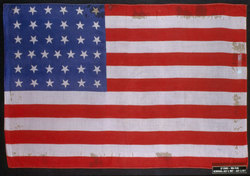

Obverse

Obverse - 2
U.S. 37 Star Flag - Nebraska Statehood.
Sub-collection: Judge John T. Ball courtroom & chambers flag collectionU.S. 37 Star Flag - Nebraska Statehood.
The journey for statehood for Nebraska had been a tedious process. In 1854, the territories of Kansas and Nebraska had been proposed to allow for the potential admission of one as a slave state and one as a free state, under the doctrine of popular sovereignty that would let the settlers decide which way the state would go. As a result, for the rest of the 1850s Kansas Territory became a battle ground between pro-slavery and abolitionist settlers. Meanwhile the settling of Nebraska was virtually ignored.
However, as the Union Pacific railroad extended across the continent after the War, settlers were drawn to Nebraska Territory. Still no attempt was made to achieve statehood until the winter of 1866-1867, when its vote was considered imperative for the ratification of the Radical Republicans constitutional amendments.
Initially vetoed by President Andrew Johnson, Nebraskas admission bill was finally adopted despite Johnsons veto on March 1st, 1867, and her star was officially added to the Union on July 4th, 1867. Thirty-seven star flags, despite its official use for a decade, show very little imagination in the arrangement of the stars. Most thirty-seven star flags tend to have their stars arranged in simple rows, even though thirty-seven is not a number readily divisible into five, six, or seven rows. As the centennial approached, there was a renewed interest in the United States flag.
Exhibition History:
First Presidio Exhibit
37 Star United States Flag
Provenance: Acquired by the Zaricor Flag Collection (ZFC0590) in 2000 from the collection of Judge John T. Ball of San Jose, CA.
Hoist & Fly | |
|---|---|
| Width of Hoist | 23.75 |
| Length of Fly | 35.5 |
Union/Canton | |
|---|---|
| Width of Union/Canton | 12.75 |
| Length of Union/Canton | 14.75 |
Stars | |
|---|---|
| Size of Stars | 1.25 |
Frame | |
|---|---|
| Is it framed? | yes |
| Frame Height | 30 |
| Frame Length | 41.5 |
Stars | |
|---|---|
| Number of Stars | 37 |
| How are the stars embeded? | Printed |
| Are there stars on obverse? | yes |
| Are there stars on reverse? | yes |
| Star Pattern | Horizontal rows of 6-6-7-6-6 five point stars. |
| Star Field Design |
|
Stripes | |
|---|---|
| Number of Stripes | 13 |
| Color of Top Stripe | Red |
| Color of Bottom Stripe | Red |
| Has a Blood Stripe? | no |
Nationality | |
|---|---|
| Nation Represented | United States |
Fabric | |
|---|---|
| Fabric | Silk |
Stitching | |
|---|---|
| Stitching | Machine |
| Comments on Stitching | Stitching on outside edges only. |
Documentation | |
|---|---|
| Documents |
All original documents and drawings are held in the Zaricor Flag Collection Archives.
|
| Drawings |
All original documents and drawings are held in the Zaricor Flag Collection Archives.
|
Condition | |
|---|---|
| Condition | Good |
| Damage | A few small holes and some discoloration. |
| Displayable | yes |
Exhibits | |
|---|---|
| Exhibition Copy | Exhibition History: First Presidio Exhibit 37 Star United States Flag Date: About 1867-1876 Medium: Printed on silk Comment: The journey for statehood for Nebraska had been a tedious process. In 1854, the territories of Kansas and Nebraska had been proposed to allow for the potential admission of one as a slave state and one as a free state, under the doctrine of popular sovereignty that would let the settlers decide which way the state would go. As a result, for the rest of the 1850s Kansas Territory became a battle ground between pro-slavery and abolitionist settlers. Meanwhile the settling of Nebraska was virtually ignored. However, as the Union Pacific railroad extended across the continent after the War, settlers were drawn to Nebraska Territory. Still no attempt was made to achieve statehood until the winter of 1866-1867, when its vote was considered imperative for the ratification of the Radical Republicans constitutional amendments. Initially vetoed by President Andrew Johnson, Nebraskas admission bill was finally adopted despite Johnsons veto on March 1st, 1867, and her star was officially added to the Union on July 4th, 1867. Thirty-seven star flags, despite its official use for a decade, show very little imagination in the arrangement of the stars. Most thirty-seven star flags tend to have their stars arranged in simple rows, even though thirty-seven is not a number readily divisible into five, six, or seven rows. As the centennial approached, there was a renewed interest in the United States flag. Provenance: Acquired by the Zaricor Flag Collection (ZFC0590) in 2000 from the collection of Judge John T. Ball of San Jose, CA. |
